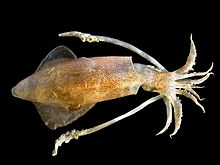(Octopus vulgaris)
(Sepia officinalis)
(Loligo vulgaris)
(Nautilus belauensis)
Pain in cephalopods is a contentious issue. Pain is a complex mental state, with a distinct perceptual quality but also associated with suffering, which is an emotional state. Because of this complexity, the presence of pain in non-human animals, or another human for that matter, cannot be determined unambiguously using observational methods, but the conclusion that animals experience pain is often inferred on the basis of likely presence of phenomenal consciousness which is deduced from comparative brain physiology as well as physical and behavioural reactions.[1][better source needed]
Cephalopods are complex invertebrates, often considered to be more "advanced" than other invertebrates. They fulfill several criteria proposed as indicating that non-human animals may be capable of perceiving pain. These fulfilled criteria include having a suitable nervous system and sensory receptors, opioid receptors, reduced responses to noxious stimuli when given analgesics and local anaesthetics used for vertebrates, physiological changes to noxious stimuli, displaying protective motor reactions, exhibiting avoidance learning and making trade-offs between noxious stimulus avoidance and other motivational requirements. Furthermore, it has been argued that pain may be only one component of suffering in cephalopods;[2] others potentially include fear, anxiety, stress and distress.
Most animal welfare legislation protects only vertebrates. However, cephalopods have a special position among invertebrates in terms of their perceived ability to experience pain, which is reflected by some national and international legislation protecting them during research.
If cephalopods feel pain, there are ethical and animal welfare implications including the consequences of exposure to pollutants, practices involving commercial fishing, aquaculture and for cephalopods used in scientific research or which are eaten. Because of the possibility that cephalopods are capable of perceiving pain, it has been suggested that "precautionary principles" should be followed with respect to human interactions and consideration of these invertebrates.
- ^ Abbott, F.V., Franklin, K.B.J. and Westbrook, R.F. (1995). "The formalin test: Scoring properties of the first and second phases of the pain response in rats". Pain. 60 (1): 91–102. doi:10.1016/0304-3959(94)00095-V. PMID 7715946. S2CID 35448280.
{{cite journal}}: CS1 maint: multiple names: authors list (link)[non-primary source needed] - ^ Moltschaniwskyj, N.A.; et al. (2007). "Ethical and welfare considerations when using cephalopods as experimental animals". Reviews in Fish Biology and Fisheries. 17 (2–3): 455–476. doi:10.1007/s11160-007-9056-8. S2CID 8639707.



